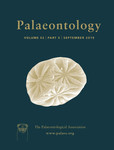Reg. Charity No. 1168330

Modularity and integration are variational properties expressed at various levels of the biological hierarchy. Mismatches among these levels, for example developmental modules that are integrated in a functional unit, could be informative of how evolutionary processes and trade‐offs have shaped organismal morphologies as well as clade diversification. In the present study, we explored the full, integrated and modular spaces of two developmental modules in phacopid trilobites, the cephalon and the pygidium, and highlight some differences among them. Such contrasts reveal firstly that evolutionary processes operating in the modular spaces are stronger in the cephalon, probably due to a complex regime of selection related to the numerous functions ensured by this module. Secondly, we demonstrate that the same pattern of covariation is shared among species, which also differentiate along this common functional integration. This common pattern might be the result of stabilizing selection acting on the enrolment and implying a coordinate variation between the cephalon and the pygidium in a certain direction of the morphospace. Finally, we noticed that Austerops legrandi differs slightly from other species in that its integration is partly restructured in the way the two modules interact. Such a divergence can result from the involvement of the cephalon in several vital functions that may have constrained the response of the features involved in enrolment and reorganized the covariation of the pygidium with the cephalon. Therefore, it is possible that important evolutionary trade‐offs between enrolment and other functions on the cephalon might have partly shaped the diversification of trilobites.